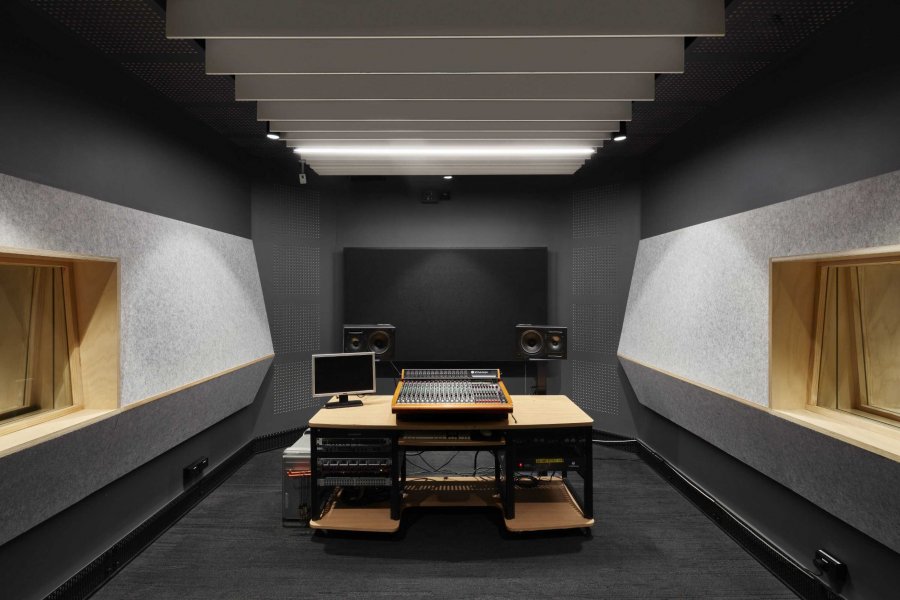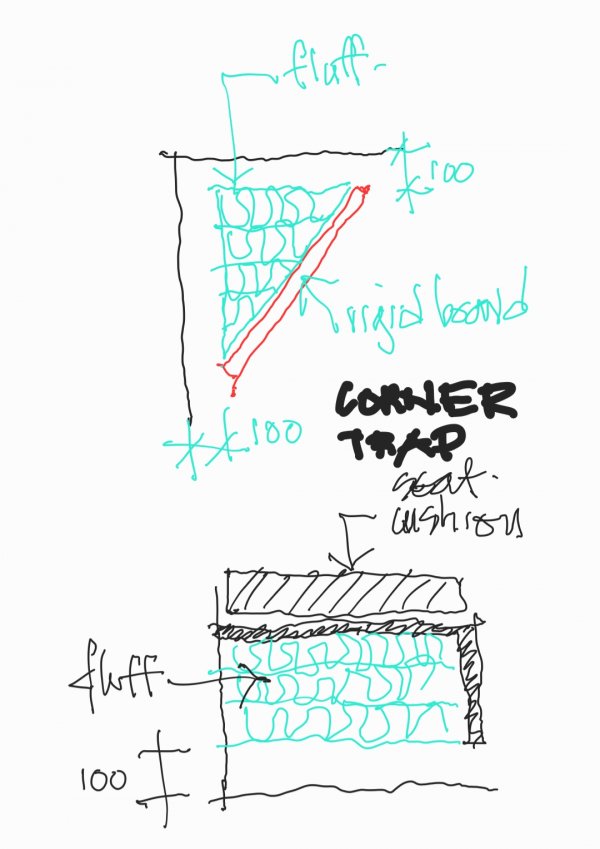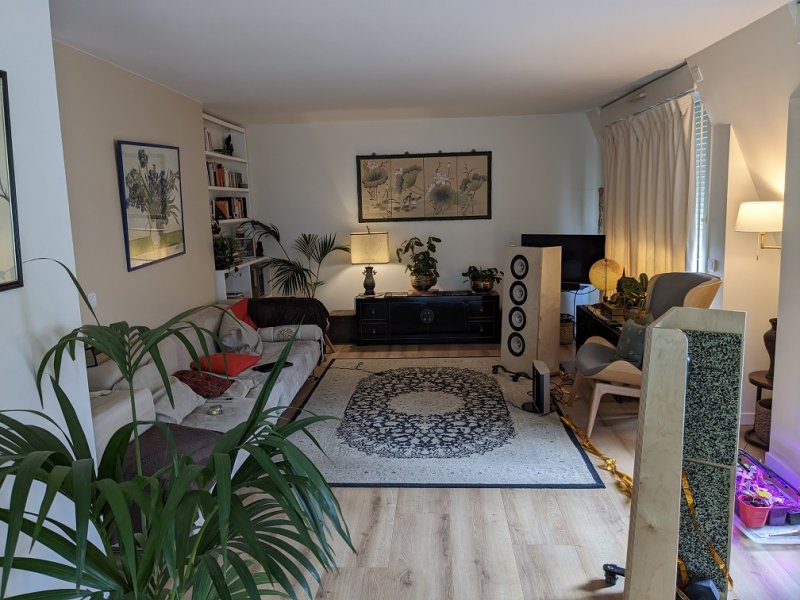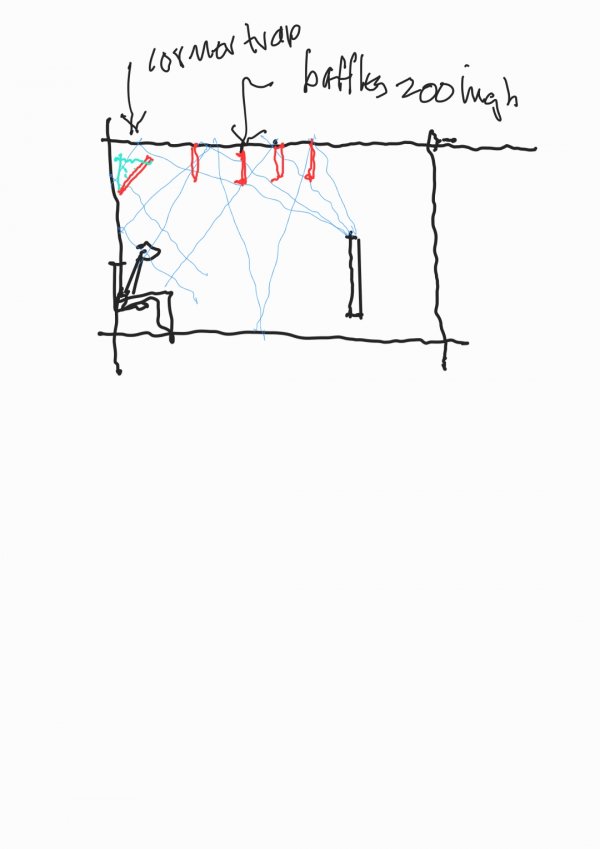Thanks. I'm skeptical about the Sugar Cubes, but curious to test them if I can get my hands on some. Will look into it.
Advice on non-intrusive room treatment for a living room
- Thread starter hopkins
- Start date
You are using an out of date browser. It may not display this or other websites correctly.
You should upgrade or use an alternative browser.
You should upgrade or use an alternative browser.
Of course you are.Thanks. I'm skeptical about the Sugar Cubes, but curious to test them if I can get my hands on some. Will look into it.
FYI: https://www.thecableco.com/sugar-cube-single.html
Last edited:
I appreciate the feedback, and am open to testing, especially since the price seems reasonable (as it should for just a small block of wood)
D
Was the resonance in the room similar with other speakersI have not listened to my speakers in a larger space.
I did try that, and both measurements and listening did not conclude to significant differences.
D
Was the resonance in the room similar with other speakers
My AudioNote speakers never worked in my current room.I bought them before moving.
As I said, I am really pleased with my current speakers. I don't plan on changing them! I can spend many hours listening without any "fatigue". They make my AN speakers sound terribly colored and veiled. I am always curious to hear new components and speakers, but I have already heard many, and I am happy with what I have today.
I am quite sensitive to "resonances", and I've heard many systems in poor rooms that have completely turned me off. This is not the case here. It is simply a matter of optimizing things.
The last RT graph I posted is pretty good (< 400 ms on average, which is acceptable for a fairly large living space). I would simply like to take things a step further... A living room is not a recording studio, and I cannot put panels everywhere. So it is going to be a gradual process, and I need to figure out what room treatment is going to make the most significant differences. Some of it may be permanent (and that includes changing some of the furniture), some may be "removable".
I think most will agree that room treatment (and lower ambient noise) is important and beneficial regardless of the type of speakers.
Open baffle speakers work very well in medium sized rooms.
That being said, I am of course aware that I will never get the type of sound in my living room that I could achieve in a naturally good sounding space, but I don't lose sleep over that, because there is nothing I can do about it.
Last edited:
Ha .. AN makes me think of bell bottom pants .. I agree !My AudioNote speakers never worked in my current room.I bought them before moving.
As I said, I am really pleased with my current speakers. I don't plan on changing them! I can spend many hours listening without any "fatigue". They make my AN speakers sound terribly colored and veiled.
I am quite sensitive to "resonances", and I've heard many systems in poor rooms that have completely turned me off. This is not the case here. It is simply a matter of optimizing things.
The last RT graph I posted is pretty good (< 400 ms on average, which is acceptable for a fairly large living space). I would simply like to take things a step further...
Open baffle speakers work very well in medium sized rooms.
Plus I am all in on dipoles .. the best for any room ! I did listen to your video and thought it sounded great
I guess I was wondering if the full range drivers that distance apart were causing lobing at hf which may contribute?
Pic below is what you need to make a small room work .. not really living room appropriate
The ceiling baffles work really well and can look quite smart .. I have used these in friends spaces and they work very well. They are just PET panels and are pretty cheap
The room has a bass and broadband trap in every corner .. ( sealed room so lots of energy reatained) as the poster above mentioned using the ceiling cornice works really well
I suspect if you calmed down the space using these ceiling treatments moving spkr away from left wall may become noticable
This is a paper on the design of room by the acoustic engineer .. it shows how the ceiling baffles are set out .. you dont need that many
[/URL]

My speakers are line arrays of 4 identical drivers (no filters). A line array on a flat open baffle generates its own issues, but it is practically impossible to tell, at this point, what is caused by the speaker and what is caused by the room. As you mention, open baffle speakers have their advantages and drawbacks, but what system does not ?
Yes, those hanging panels are not going to get my girlfriend’s approval. However, i would be curious to try this (considering it is cheap) just to see for myself how much of an improvement it makes. Smallish cornices on the ceiling/wall intersections (also recommended by someone else on this thread) could definitely work in my room. The exterior wall is already slanted on top, so visually it would fit in...
Yes, those hanging panels are not going to get my girlfriend’s approval. However, i would be curious to try this (considering it is cheap) just to see for myself how much of an improvement it makes. Smallish cornices on the ceiling/wall intersections (also recommended by someone else on this thread) could definitely work in my room. The exterior wall is already slanted on top, so visually it would fit in...
Last edited:
the link does not work. Can you check it ?This is a paper on the design of room by the acoustic engineer .. it shows how the ceiling baffles are set out .. you dont need that many
[/URL]View attachment 108816
Sorry not sure what happened.. its a pdf downloadthe link does not work. Can you check it ?
You could do tempoary baffles with any rigid absorbent board you may already have .. if they worked there are plenty of elegant ways of achieving a similar result with say timber battens and black absorber behind
Cornice needs to have some depth to work
I ordered basotect corner bass traps to test them on the ceiling/wall intersection above my couch. They are very light, so it will be easy to tape them temporarily. I am not sure how effective basotect is in this context, but it's worth a shot. I will also try them placed vertically in the corner behind the left speaker.
I also ordered a few rectangular basotect panels to play around with on the ceiling and walls. If rigidity is an issue, I'm thinking of adding corrugated cardboard behind them.
If some of these tests are conclusive, I can then think about devising a system of detachable panels (with thin magnetic strips, for example). The corner traps could be set up permanently, however (and for those I could then consider more efficient absorption material).
Basotect cannot be painted, but it can be covered with acoustically transparent fabric.
As mentioned, my entire system in my living room is normally hidden out of view, and it takes me a couple minutes to set everything up anyway.
Last edited:
Cool .. that should be interestingI ordered basotect corner bass traps to test them on the ceiling/wall intersection above my couch. They are very light, so it will be easy to tape them temporarily. I am not sure how effective basotect is in this context, but it's worth a shot. I will also try them placed vertically in the corner behind the left speaker.
I also ordered a few rectangular basotect panels to play around with on the ceiling and walls. If rigidity is an issue, I'm thinking of adding corrugated cardboard behind them.
If some of these tests are conclusive, I can then think about devising a system of detachable panels (with thin magnetic strips, for example). The corner traps could be set up permanently, however (and for those I could then consider more efficient absorption material).
Basotect cannot be painted, but it can be covered with acoustically transparent fabric.
As mentioned, my entire system in my living room is normally hidden out of view, and it takes me a couple minutes to set everything up anyway.
Corner bass traps work well when spaced away from wall .. might be a challenge for a temporary fit though
Another cool spot for asborbtion is under banquette seating or for broadband under a coffee table or similar .. very discrete

I can add spacing, no problem.
Interesting option to add stuff under my couch/chairs.
Thanks
Interesting option to add stuff under my couch/chairs.
Thanks
Last edited:
Yes I have seen 100mm semi rigid absorber under tables in a restuarant .. it all adds up to control reverbI can add spacing, no problem.
Interesting option to add stuff under my couch/chairs.
Thanks
I spend the entire day playing around with speaker placement and various acoustic panels, measuring and listening. I ended up moving my speakers further into the room, as was suggested. Reverberation of lower frequencies (problematic with the left speaker) is much lower, and the frequency response of the two speakers are more closely aligned.

I did try placing some panels hanging from the ceiling above my couch, as was also suggested, and it seems to have more effect than placing panels against the wall above my couch, but it is not "viable"... There are a couple more windows that I can put curtains on, and will see after if I need to do much else.

I did try placing some panels hanging from the ceiling above my couch, as was also suggested, and it seems to have more effect than placing panels against the wall above my couch, but it is not "viable"... There are a couple more windows that I can put curtains on, and will see after if I need to do much else.
Low frequency issues are always harder to solve. But for the midrange and treble, looking at the photos, I now do think that a lot of the extra resonance are coming from the windows.I did try placing some panels hanging from the ceiling above my couch, as was also suggested, and it seems to have more effect than placing panels against the wall above my couch, but it is not "viable"... There are a couple more windows that I can put curtains on, and will see after if I need to do much else.
But were you able to try putting those throw pillows you have on your couch and put them right behind your ears when you're listening to music? The pillows should sit on top of the back of the couch in a very stable manner so that the trebles (and midrange) won't hit the back wall and bounce right back into your ears. I've found even though the pillows are not professional acoustic panels, they still do a good enough job that it helps preserve the aesthetics. Sometimes you might need to move the pillows slightly because it all comes down to where the first reflection point is from your speaker to the back wall back into your ear as you'll want a throw pillow there.
Low frequency issues are always harder to solve. But for the midrange and treble, looking at the photos, I now do think that a lot of the extra resonance are coming from the windows.
But were you able to try putting those throw pillows you have on your couch and put them right behind your ears when you're listening to music? The pillows should sit on top of the back of the couch in a very stable manner so that the trebles (and midrange) won't hit the back wall and bounce right back into your ears. I've found even though the pillows are not professional acoustic panels, they still do a good enough job that it helps preserve the aesthetics. Sometimes you might need to move the pillows slightly because it all comes down to where the first reflection point is from your speaker to the back wall back into your ear as you'll want a throw pillow there.
Yes, when I listen I place pillows behind me (or panels that I store under the couch...). It does help a little. I should probably replace the glass-covered frame above the couch as well, with something decorative and absorbant, as someone suggested. That will come.
Windows are an issue both in terms of reflections and sound "leakage" from the outside (unless you live in the countryside...). The acoustic curtain I installed on that large window does work to some extent, but not for low frequencies from the outside (which is what I hear, even though I am on the 7th floor, when a truck passes my building). Short of replacing the windows, which are already double-pane, but not great quality, there is not much I can do about that. Good thing I do not live on a busy street...
There is an additional tall window just to the left of the right speaker, and a smaller one to the right - I need to place curtains on both.
Last edited:
Great that you've achieved some improvements. A day well spent!
Can I ask what the angle between you and your speakers is? Or, easier to measure, the distance between the 2 speakers and the distance between each speaker and your ears.
Also, I've just noticed something. The wall oposite your sofa slopes. I guess it's a top floor flat. I don't know if this is a good or bad feature, or what could be done to reduce its impact if it's an undesirable feature. Others may have a view on this.
I must say, I'd like to see horn speakers (used Avantgarde Unos perhaps) that could be placed close to the wall and less likely to be upset by the room's features.
Can I ask what the angle between you and your speakers is? Or, easier to measure, the distance between the 2 speakers and the distance between each speaker and your ears.
Also, I've just noticed something. The wall oposite your sofa slopes. I guess it's a top floor flat. I don't know if this is a good or bad feature, or what could be done to reduce its impact if it's an undesirable feature. Others may have a view on this.
I must say, I'd like to see horn speakers (used Avantgarde Unos perhaps) that could be placed close to the wall and less likely to be upset by the room's features.
Similar threads
- Replies
- 1
- Views
- 483
- Replies
- 0
- Views
- 598
- Replies
- 17
- Views
- 3K
- Replies
- 15
- Views
- 2K
| Steve Williams Site Founder | Site Owner | Administrator | Ron Resnick Site Owner | Administrator | Julian (The Fixer) Website Build | Marketing Managersing |


